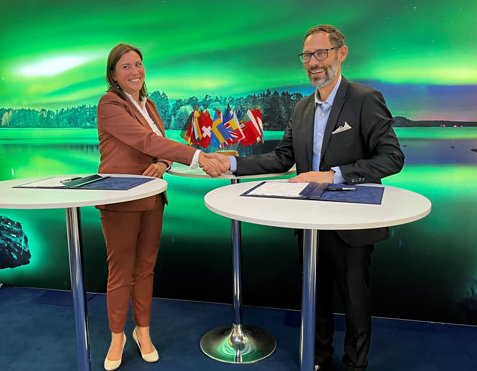CAES Wins Contracts for Development of Next-Generation, Octa-Core, user-selectable CPU for Space
PARIS, France. - September 23, 2022 — CAES, a leader in advanced mission-critical electronics for aerospace and defence, announced that it has won multiple contracts with the European Space Agency (ESA) for the development of the GR765 System-on-Chip (SOC), the first user selectable CPU for space. This next-generation, radiation-hardened device will allow users to select between the LEON5 SPARC V8 or NOEL-V RISC-V RV64 processor cores.
CAES previously received funding from the Swedish National Space Agency (SNSA) within ESA’s General Support Technology Program (GSTP) for the preliminary GR765 system requirement development. In parallel, a demo chip with LEON5 and NOEL-V fault tolerant cores has been fabricated on STMicroelectronics’ 28nm FDSOI technology. The new incremental Advanced Research in Telecommunications Systems (ARTES) and Technology Development Element (TDE) program contracts will enable CAES to move forward with the GR765 prototype development and manufacturing on this technology.
The official contract signing took place at the International Astronautical Congress (IAC) in the Swedish pavilion, September 22, 2022, in Paris, France. The Director of Telecommunications and Integrated Applications at ESA, Elodie Viau and CAES Gaisler Product’s General Manager, Sandi Habinc were in attendance.
“ESA is proud to collaborate with CAES in developing this next generation of data processing technology which is instrumental to build intelligent, powerful and secure systems in space. Our cooperation will enhance Europe's capacity to launch and conduct its ambitious future missions and puts us in a pole position to advance the global technological standard for data processing in space,” said Elodie Viau, Director of Telecommunications and Integrated Applications at ESA.
“The CAES GR765 responds to the ever-increasing demands of telecommunication payload data processing, but also benefits a broad range of other mission-critical applications such as on-board computing,” said Michael Harverson, Head of the Space Segment Section at ESA.
“CAES is excited to announce the first user-selectable CPU for space. We are providing our customers with options to select the best architecture based on their requirements, while meeting the space industry’s future needs for more computing and a seamless ecosystem as well as addressing Size, Weight and Power (SWaP),” said Mike Elias, Senior Vice President and General Manager, Space Systems Division, CAES.
CAES will work closely with STMicroelectronics, a leading European semiconductor company, on product manufacturing and qualifications for the GR765. “We are proud to team with CAES on their next-generation microprocessors for space. The combination of proven SPARC and RISC-V technology with 28nm FDSOI’s technology capability and maturity for space is a perfect match,” said Francois Martin, Head of Space & Defense ASICs Business Development, Microcontroller & Digital Group, STMicroelectronics. “In addition to silicon manufacturing, ST provides HiRel product manufacturing and qualification through its trusted supply chain in its factories in Crolles and Rennes, France.”
The GR765 System-On-Chip will offer greater flexibility and functionality while providing the higher processing and bandwidth needed for future space applications. It will also allow the user to reuse legacy LEON SPARC software or develop new software for the NOEL-V RISC-V architecture, providing the option to leverage state-of-the-art software developed in other industries.
Based on the radiation test on the demo chip, CAES estimates the SEU tolerance for the GR765 product to be at least five times harder than the current radiation hardened processors. CAES will implement its legacy approach to fault tolerance, allowing software to transparently continue execution in presence of correctable errors, as well as extending fault tolerance to peripherals and software libraries.

About CAES
CAES is a pioneer of advanced electronics for the most technologically challenging military and aerospace trusted systems. As the largest provider of mixed-signal and radiation-hardened technology to the United States aerospace and defence industry, CAES delivers high-reliability RF, microwave and millimeter-wave, microelectronic and digital solutions that enable our customers to ensure a safer, more secure planet. On land, at sea, in the air, in space and in cyberspace, CAES’ extensive electronics and enhanced manufacturing capabilities are at the forefront of mission-critical military and aerospace innovation. www.caes.com
About ESA’S ARTES Core Competitiveness Programme
ESA’s ARTES (Advanced Research in Telecommunications Systems) program is unique in Europe and aims to support the competitiveness of European and Canadian industry on the world market. Core Competitiveness is dedicated to the development, qualification and demonstration of products (“Competitiveness and Growth”), or long-term technology development (“Advanced Technology”). Products in this context can be equipment for the platform or payload of a satellite, a user terminal, or a full telecom system integrating a network with its space segment.
Find out more at: https://artes.esa.int/core-competitiveness
Related Semiconductor IP
- Compact Embedded RISC-V Processor
- Neuromorphic Processor IP
- Flexible Pixel Processor Video IP
- Neural Video Processor IP
- GPNPU Processor IP - 32 to 864TOPs
Related News
- LEON3 has passed SPARC V8 compliance testing
- Atmel Introduces the AT697F Radiation-Hardened SPARC V8 Processor for Space Missions
- Daiteq Selected as the First ESA NOEL-V User
- The European Space Agency (ESA) has awarded a contract to CAES, in the frame of the ARTES Competitiveness & Growth programme, to develop System-on-Chip for space applications
Latest News
- Weebit Nano secures a license agreement with Texas Instruments
- Digital Blocks DB9000 Display Controller IP Core Family Extends Leadership in 8K, Automotive, Medical, Aerospace, and Industrial SoC Designs
- AI Directs UFS Advancement
- Qualitas Semiconductor Expands Automotive Momentum with 5nm IP Bundle Agreement
- Cyient Semiconductors Acquires Majority Stake in Kinetic Technologies to Drive Custom Power IC Leadership for Edge AI and High-Performance Compute Markets